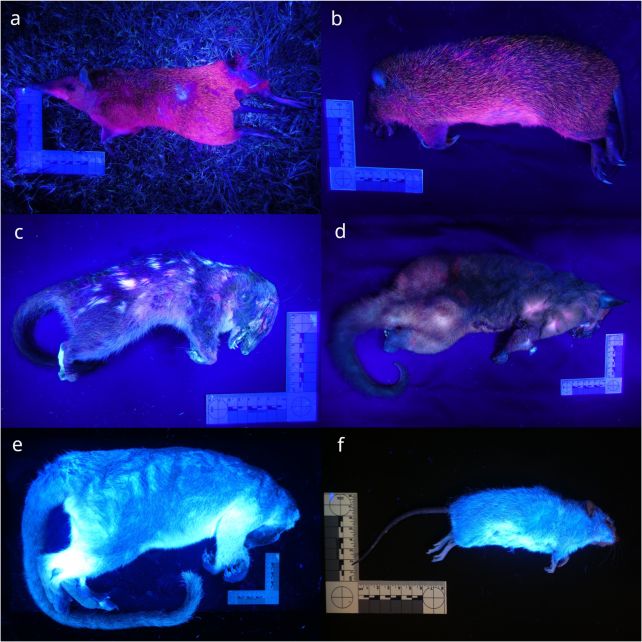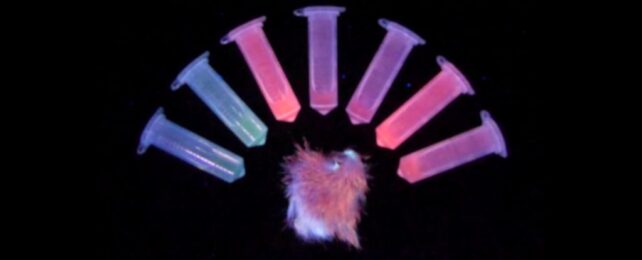It turns out that a shocking number of mammals can glow in the dark.
Shine a blacklight on a mob of Australian animals and you'll be forgiven that you've somehow found your way into a bush doof. But it's not just Australia. A 2023 study revealed that a lot of mammals exhibit biofluorescence under ultraviolet light.
Why? We don't know. But a new study into the chemistry of the photoluminescence of Australian animals may shed some (metaphorical) light on the matter. How? By shaving fur off roadkill and doing science on it.
Biofluorescence is a type of biological glowing in which light is absorbed and reemitted at a different wavelength by molecules called luminophores.
It's distinct from bioluminescence, in which a glow is actively and independently produced by the organism, like fireflies. Biofluorescence requires a light source to absorb.
Lots of animals fluoresce: chameleons, fish, sea turtles, and frogs are all notable examples. Proteins like keratin and collagen mean hair, claws, whiskers, bones, and teeth can all be biofluorescent.
But in 2020, scientists got a huge surprise when shining UV light on a taxidermied platypus specimen: its fur glowed much more strongly than the low-level glow expected from keratin. The experiment, when repeated on a wombat and other Australian animals, revealed that they have a special aura, too. Ultimately, researchers found more than 125 glowing mammals.
What's interesting about this phenomenon is that it's not ubiquitous. It's seen in some mammals, including some marsupials, and monotremes (not that there are many of those).
This could mean that the fluorescence has some sort of evolutionary advantage – but it could also be an evolutionary accident. Figuring out how the animals fluoresce is an important step on the journey to the why, so a team led by zoologist Linda Reinhold of James Cook University in Australia set out to investigate.
The researchers wanted to use high-performance liquid chromatography and electrospray ionization mass spectrometry to analyze the chemistry of the fur of several animals that are known to be fluorescent.
These techniques involve separating the molecules in the sample into a liquid, and a gas, respectively; as you can imagine, they are quite destructive to the sample, which is not ideal for taxidermy specimens housed in museum collections.
So, the researchers turned to another resource: roadkill. They clipped the fur off deceased animals found at the side of the road, and performed their tests.

"The fur of the Australian northern long-nosed and northern brown bandicoots photoluminesces strongly, displaying pink, yellow, blue and/or white colors. We wanted to find out whether the luminophores present in bandicoot fur might be common across multiple species," Reinhold explains.
"So, we compared the results from the two bandicoots to the northern quoll, the coppery brushtail possum, the Lumholtz's tree-kangaroo, the pale field rat and the platypus – all of which photoluminesce in different ways."
Their analyses showed that a luminophore called protoporphyrin was present in all the animals tested. However, each specimen had multiple types of luminophores, and they varied from animal to animal.
"A luminophore consistent with uroporphyrin was also identified in both pink-photoluminescent species of bandicoot, heptacarboxylporphyrin in one bandicoot, and coproporphyrin in a bandicoot and the pink-photoluminescent northern quoll," the researchers write in their paper.
"We only isolated two luminophores with molecular ions consistent with known tryptophan metabolites that have been documented previously in the pelage of other mammals."
This does suggest that there could be a reason for the glow, although we're still in the dark (pun intended) about what that reason is. Scientists think it may have something to do with the crepuscular lifestyle of many of the mammals that have it. Maybe it's so these animals can recognize each other in low-light conditions.
Or it could just be a complete accident with no purpose at all; after all, if a trait doesn't reduce your chances of survival, evolution has no need to phase it out.
Solving the puzzle is probably going to require a lot more analysis; this is just a small piece of a much larger biological picture. It is, however, a significant one.
"This study," the researchers write, "is the first chemical analysis of luminophores contributing to photoluminescence in the fur of Australasian mammals since two tryptophan metabolites were identified more than 50 years ago."
The findings have been published in PLOS ONE.
